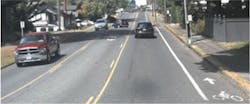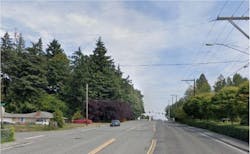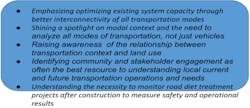Rethinking how we view existing roads
There is growing support in Washington State for transportation infrastructure that accommodates all people using all modes of transportation.
One of the ways the Washington State DOT (WSDOT) is able to achieve this is by rethinking how it uses the existing right of way to improve safety for all users, and road diets play a part in this movement.
The primary benefits of a road diet are improved safety, operational benefits, and livability benefits.
- Safety Benefits
- Reduce speeds
- Reduce conflicts between people in vehicles and people using other modes of transportation
- Decrease crash severity
- Shorten street crossings
- Operational Benefits
- Separate left-turn vehicles
- Improve sight distance for cross streets/driveways
- Possibly eliminate weaving movements
- Livability Benefits
- Improve comfort level for all users
- Invite people to make more trips by walking and bicycling
Road diets and retrofit options are discussed in WSDOT’s Design Manual, Geometric Cross Section – Highway chapter. The section states:
Additionally, the Design Manual discusses retrofit options, which is the application of lower-cost treatments that utilize paint and other delineation devices rather than hardscape features.
WSDOT's road diet guidance is consistent with the Federal Highway Administration’s road diet Informational Guide (FHWA-SA-14-028).
When the number of vehicle lanes is reduced, the extra space can be reallocated for other uses such as bike lanes, pedestrian refuge islands, transit uses, and curbside parking. Some factors to consider in a road diet treatment include: the number of people driving, current and potential pedestrian and bicycle volumes, the number of people using transit, existing and designed speed limit, the number of driveways, non-intersection turning volumes, and land use along the corridor.
An example of a typical road diet treatment is the S.R. 500 Camas Bike Lanes and center turn-lane project in the city of Camas, Washington. The city wanted to promote slower speeds with a road diet that included the addition of bike lanes on both shoulders. A series of residential streets connects with S.R. 500 while passing through a neighborhood, a school zone, and a series of crosswalks. Together, WSDOT and the City of Camas engaged with local community residents on the changes, including removal of on-street parking.
Project benefits included:
- New striping that encourages a more uniform operating speed.
- Safer roadway and school crossings through reduced lane width.
- A designated lane for left-turn movements and shorter crossing distances for pedestrians.
- Improved driver sight distance and space for bike lanes by removing all parking.
- Enhanced multimodal travel with connections for cyclists from the city center to the local bike network.
In addition to the road diet and retrofit options section in the Design Manual, WSDOT created other platforms to incorporate road diet concepts and applications that are in line with the goals and benefits of a road diet treatment, which are to provide safety, operational, and livability benefits.
One platform that WSDOT has to promote safety and provide access for all modes of transportation is the Context and Modal Accommodation report to document context and modal priority for non-freeway projects. The intent of the accommodation report is to look at a project from a multimodal perspective, basically to identify multimodal opportunities on projects.
The WSDOT Practical Solutions approach shares many of the philosophical underpinnings that guide Road Diets. The goal of Practical Solutions is to identify and solve problems as quickly and inexpensively as possible while building towards a more sustainable, integrated, multimodal transportation system. The approach uses performance-based, data-driven decision-making and early community involvement to guide the development and delivery of transportation investments.
An example of a project that incorporates many of the road diet concepts and applications is the S.R. 526/S.R. 525 to Boeing Access & S.R. 525 Spur/Paving & ADA Compliance project. The prompt for this project was to rehabilitate existing pavement and preserve the integrity of the roadway structure, as well as delineate and retrofit curb ramps. The original concept for the project would have simply restored the existing channelization after paving was completed. However, engagement with stakeholders and a practical solutions approach led to a more multimodal plan.
The City of Mukilteo adopted their Bicycle, Pedestrian and Trails Plan in 2009 that included adding bicycle routes in the paving project vicinity. The segment is a primary connection between residential areas, regional employers, the Mukilteo Ferry Terminal, and numerous local origins and destinations. Discussions between WSDOT and the City of Mukilteo resulted in revisions to the striping plan on the segment of S.R. 526 between S.R. 525 and Paine Field Boulevard to provide a bicycle lane in each direction. Westbound travel was reduced to one lane to accommodate bicycle lanes for both directions after reviewing and analyzing the traffic volumes.
Project benefits include:
- Addressing a gap in the bicycle network, giving people the option to bicycle along S.R. 526 using new dedicated bicycle lanes in each direction.
- Reducing crash exposure for people crossing the street with a reduction in vehicle lanes from four lanes to three lanes.
- Narrowing the roadway and incorporating new features under the planned re-striping to encourage people to drive slower, which is especially important for a roadway that has a history of speeding, particularly on downhill slopes.
WSDOT procedures included:
- Agency engagement: Discussions between the City Mukilteo and WSDOT staff identified a desire from the City of Mukilteo to add bicycle lanes.
- Modal context: Reviewing the multimodal context, in collaboration with the City of Mukilteo, played a large role in adding the bicycle lanes.
- Practical solutions: WSDOT was able to communicate and analyze the request to add the bicycle lanes and modify the original scope of work to add the bicycle lanes with minimum impact to the project schedule and budget.
Washington State has multiple other example projects that incorporate road diet concepts and applications similar to the S.R. 526/S.R. 525 to Boeing Access & S.R. 525 Spur/Paving & ADA Compliance project, including:
- S.R. 4 Cathlamet Road Diet Project, City of Cathlamet, Washington: This project converted an existing S.R. 4 climbing lane that went through the community (there were three lanes of S.R. 4 in this vicinity), and revised it to a two-lane highway with left-turn lanes at specific intersections, and two-way-left-turn-lane between intersections.
- S.R. 527/Bothell to Dumas Rd—Pedestrian & Bicycle Improvements project, city of Bothell, Washington: This project improved pedestrian and bicycle facilities on S.R. 527 corridor from Bothell to Mill Creek by installing painted bike lanes along the corridor and flashing yellow arrows at key signalized intersections to improve safety.
Conducting road diet projects has resulted in many internal benefits to WSDOT’s approach and practices on projects, including:
Road diet, road buffet, road relocation, complete streets, right-sized streets, vision zero, target zero, practical solutions—all of these concepts and applications have many of the same goals and desired outcomes: to find low-cost solutions within existing roadway infrastructure to improve safety, operational, and livability benefits for all users.
For more information on WSDOT practices on the subject, visit:
- https://www.wsdot.wa.gov/publications/manuals/fulltext/M22-01/design.pdf
- https://www.wsdot.wa.gov/about/practical-solutions
- https://www.wsdot.wa.gov/planning/SHSP.htm
- https://www.wsdot.wa.gov/travel/commute-choices/bike/plan
- https://aashtojournal.org/2018/07/20/wsdots-roger-millar-we-must-become-stewards-of-the-transportation-system
- https://visionzeronetwork.org/talking-with-barb-chamberlain-of-washington-state-department-of-transportation/





